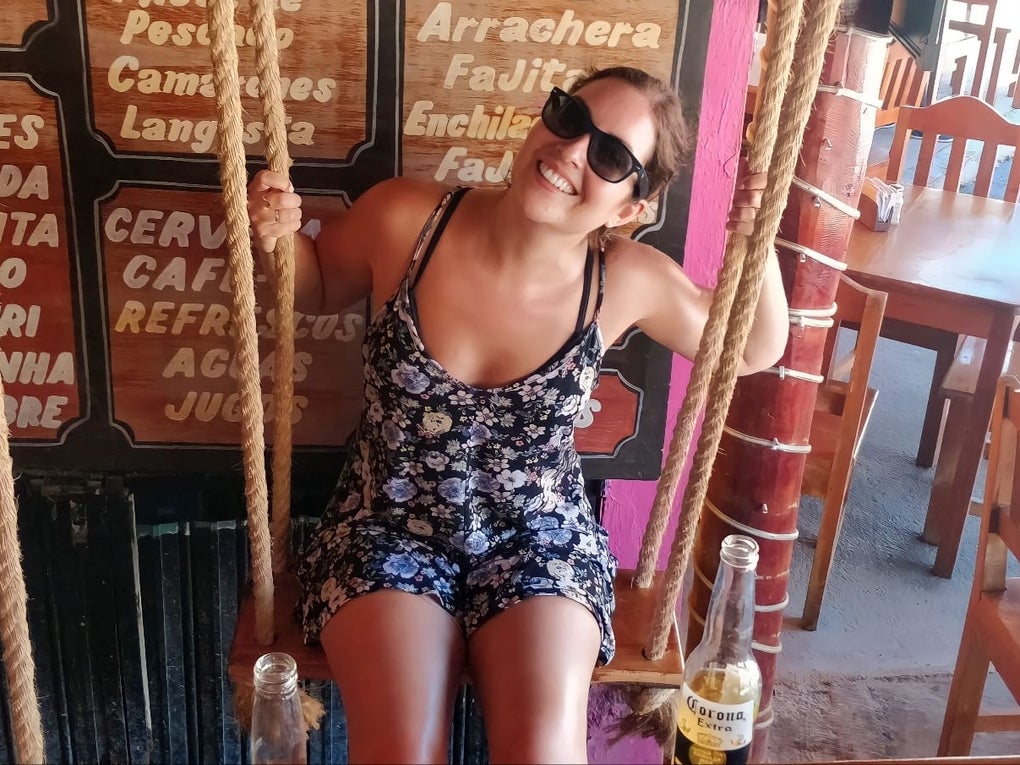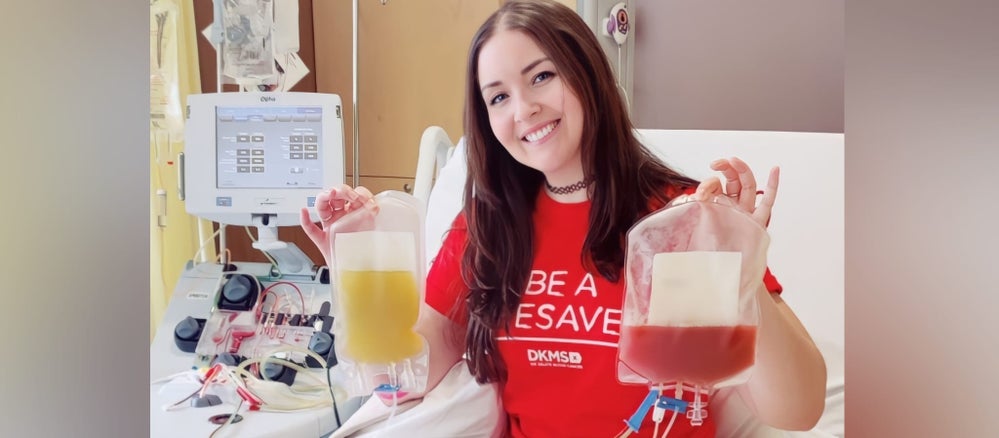
My stem cell donation journey
Almost exactly a year ago, I donated my stem cells to a critically ill patient. I've documented my story with the aim of educating and encouraging others to register as potential donors.
Over 2,000 people each year in the UK need of a blood stem cell transplant. However, just 3% of the population are registered as potential donors. A blood stem cell donation is often the last chance to beat blood cancer, and 50% of people never find a donor. Patients require donors whose tissue characteristics are a 100% match, and finding such a twin is like looking for a needle in a haystack.
If you're 17-55 years old and in general good health, please consider requesting a swab kit to become a potential lifesaver via the DKMS website.
Why I registered
A year ago, I began what might be the most important thing I'll ever do. I donated my stem cells to a terminally ill young adult from Germany.

Having parted with four million stem cells and two bags of plasma, I felt great. Emotional, proud, exhausted, bruised - yes, but great. If you're wondering how I got there, read on.
In 2016, a work colleague told me about a stem cell donor register she'd signed up with called DKMS. An ever-curious person, I Googled the website and learned what they do. Donating stem cells seemed quick, easy, and incredibly valuable, so I signed up, received my cheek swab kit, and returned it. Five years went by with no thought about it at all. Until the summer of 2021.
A potential match
In July of last year, DKMS called. I had been tissue-matched against a blood cancer patient in urgent need of a stem cell transplant and I was their 'genetic twin'. I was asked if I was still willing to donate my stem cells (yes) and completed a questionnaire similar to those you fill out before donating blood. Then, we arranged further confirmatory typing via two blood tests, which determined other mitigating factors, such as if I'd ever had cytomegalovirus, as the patient and I had to match there too. Everything came back compatible, I was given thorough information on what would happen next in terms of preparation and any side effects, etc, and I was again asked if I would commit to donating (yes!).
Preparing to donate
I was invited to London for a full physical assessment, which included all the tests and checks on my health as you can possibly imagine. After about a week, I was given the go-ahead for the donation; my patient had a very small window to receive the transplant, so it had to happen fast. At this point, the patient commenced chemotherapy and radiotherapy to destroy their immune system in preparation of receiving my cells. It was described to me as their 'point of no return'. So I isolated myself for two weeks to avoid getting COVID. Still managed to fracture my big toe, though.
To ensure enough cells are collected, donors receive daily granulocyte colony-stimulating factor (G-CSF) injections for four to six days before donation. This growth factor is naturally found in the body, but the extra G-CSF increases the number of stem cells and white blood cells produced in red bone marrow, found in the ribs, vertebrae, sternum, and bones of the pelvis, and flushed into the bloodstream. This is called mobilising the stem cells. In the last week of my isolation, I received these injections in the subcutaneous tissue of the back of each arm, from a nurse who visited me for four days.
This was probably the most difficult part. The injections themselves were fine - I didn't feel them - but after the first 24 hours passed I started to feel generally unwell. Many donors report that the injections make them feel ill, a bit like having the flu, and I definitely ached all over. My sinuses, fingers, lower back, and pelvis/hips were the most uncomfortable, and I had a constant headache. I knew that the side effects would resolve within 24 to 48 hours after stopping the G-CSF. I managed the discomfort with paracetamol (NO ibuprofen allowed). The end goal of potentially saving someone's life easily trumps a little malaise. Another potential side effect of G-CSF can be a temporary enlargement of the spleen, which I didn't feel at all if it occurred. However, all donors are still asked to not do any strenuous physical activity from the first day of G-CSF to the sixth day after donation.
Stem cell donation

My donation day arrived and I stayed in London for two nights, which again was covered by DKMS. I donated via peripheral blood stem cell (PBSC) donation, which is the method used in 90% of cases and involves a special intravenous line in veins of both arms. Blood is taken from one arm, passed through an apheresis machine, mixed with anticoagulant and saline, separated via centrifugation, and then returned to a vein in your other arm, sans stem cells. It all takes between four and six hours. Only 10% of donors actually have stem cells collected from their pelvis under general anaesthetic.
During the donation, I had to do everything left-handed as the nurses could only find a suitable 'giving' vein in my right arm and 'receiving' vein in my left hand (you are only allowed to move your "receiving" arm throughout the donation) – typical me. It was weird seeing my blood travel inside the tubes and make its way back into my hand. I was well looked after, had warm electric blankets wrapped around my arms, lovely food, and somehow managed to hold my bladder the whole six-and-a-half hours.
Six hours and 8.3 litres of processed blood later, I had produced a bag of yellow plasma and a bag of red stem cells to give to my patient.
Only, that wasn't the end of the story. Sometimes, it's not possible to donate enough stem cells during one session, and I had more G-CSF injections and asked to return the next day. Very rarely is a second outpatient collection needed.
It's important to me to document my donor journey in the most realistic and truthful way possible: day two was tougher. The cannula site in my hand was sore and bruised, so they couldn't use that vein again. They tried my arm, and it took four attempts to access a vein without it collapsing. I was very close to having a peripherally inserted central catheter (PICC line).
After the donation
Another bag of plasma and a bigger bag of stem cells later, my donation was over. I consented to being 'on call' in case my patient ever needs more stem cells, and that night, my harvested cells were flown to wherever the patient is in the world, ready for transplant the following day. The DKMS team followed up with me over the next two weeks to ensure I was well.
How is my patient?
In January this year, I received news on my patient's condition for the first time since transplant. My patient had survived! And was recovering well!
I can't lie, I cried happy tears when I heard. I was also allowed to know a few details about the patient - they're from Germany and between 20 and 30 years old. What a wonderful feeling!
In July, once again I heard from the patient's team. Since January's update, my patient continued to do well and has been able to start returning to their normal daily routine alongside regular check-ups as part of post-transplant treatment.
Every time I think about this, I'm overwhelmed by the gravity and remarkable nature of what has taken place. I cannot describe the gratitude I feel to have been allowed this opportunity to use my life for something so precious. This person has acquired my O-blood group and entire immune system. We're "genetic twins". They beat their blood disorder/cancer.
There is at least a two-year period of anonymity between donors and recipients; however it is possible to contact each other anonymously by letter or email, so I have sent an email so far. If and when the time comes, I cannot wait to talk with and meet my patient. It was the best thing I've ever done - and probably ever will do - in my life. How many people can say they've saved someone's life? It was, at times, a testing experience but a real privilege. I've realised that I needed this almost as much as my recipient.
The important facts
Unfortunately, for most patients, a blood stem cell donation is their last chance to beat blood cancer, and around 50% of patients 'never' find a donor. Patients require donors whose tissue characteristics (HLA) are a 100% match, and finding such a twin is much like looking for a needle in a haystack. There are more than 20,000 known HLA characteristics that can occur in millions of combinations in every individual, much like fingerprints. Patients of more diverse ethnic backgrounds tend to have more diverse HLA types, making it even more difficult to find a match.
This is what I ask
If you're 17-55 years old and in general good health, (especially if you're male and belong to a BAME group) please consider:
- signing up to the stem cell registry, or
- making a financial donation to DKMS UK
to help more people beat blood cancer. Registering is super quick and only involves a cheek (not tonsil) swab that you send back in the post. The more donors that sign up to join the register, the more lives can be saved.
Thanks for reading my story. If you have any questions about the donation process, please feel free to contact DKMS.


